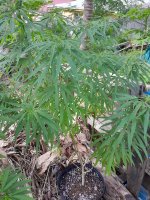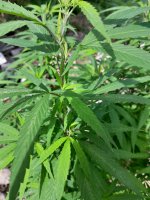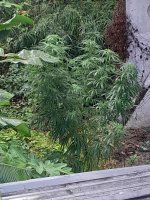You are using an out of date browser. It may not display this or other websites correctly.
You should upgrade or use an alternative browser.
You should upgrade or use an alternative browser.
Plants not flowering
- Thread starter Islandgrower
- Start date
sneakyfeck
2024 Circle of Excellence
i did have this problem once but in my case it was due to light pollution. Is there a street lamp shining on them at night?
slabsofdank
2021 COE Winner
If not light contamination. They just need more hrs of darkness. Cover them a couple hrs before sunset to trigger them.
quinxstar
'21, '23 COE Winner
i got a male of kuamoni india never blooming
and a girl of laos never blooming the plant was start outdoor i no see a start of blooming so i put it 2 month in 12/12 indoor never see a bud starting i have give it up
i think is more from the landrace
what is the strain ?
and a girl of laos never blooming the plant was start outdoor i no see a start of blooming so i put it 2 month in 12/12 indoor never see a bud starting i have give it up
i think is more from the landrace
what is the strain ?
Islandgrower
2021 COE Winner
It was from seeds which came from plants of mrnice gear. They were all in the same area so not sure why only those 2 did not floweri got a male of kuamoni india never blooming
and a girl of laos never blooming the plant was start outdoor i no see a start of blooming so i put it 2 month in 12/12 indoor never see a bud starting i have give it up
i think is more from the landrace
what is the strain ?
i did have this problem once but in my case it was due to light pollution. Is there a street lamp shining on them at night?
They do have lights nearby but the others flowered in the same location. Even gave them 48hrs of darkness and still not flowering
Islandgrower
2021 COE Winner
I noticed that it was said lights nearby were shining but other plants flowered and finished from the same pack of seeds.
The fact the others were not effected by light doesn’t mean they are not effected for every female is different especially MNS.
Moving them away from the building light may be the only way to rule out it’s not from light during dark cycle.
The fact the others were not effected by light doesn’t mean they are not effected for every female is different especially MNS.
Moving them away from the building light may be the only way to rule out it’s not from light during dark cycle.
Islandgrower
2021 COE Winner
Had a clone and planted it in the ground in another spot and it is getting huge lol. Still no flowers in sight it is already 6 or 7ft Tall.I noticed that it was said lights nearby were shining but other plants flowered and finished from the same pack of seeds.
The fact the others were not effected by light doesn’t mean they are not effected for every female is different especially MNS.
Moving them away from the building light may be the only way to rule out it’s not from light during dark cycle.
Skuncle Lenny
'23, '24 COE Winner
Zamalyou may have a neighbor who grows zamal and who has polenized your plants
one year for a bloom
My 1st real entry into regular seeds started with ZamalDelica from ACE, which WAS my favorite Sativa, until MrNice.
quinxstar
'21, '23 COE Winner
ROFLHad a clone and planted it in the ground in another spot and it is getting huge lol. Still no flowers in sight it is already 6 or 7ft Tall.
Uncle Jack
Well-known member
I found my way to Ace because of the regular seeds, then I followed the cookie crumbs and landed here as well.Zamal.
My 1st real entry into regular seeds started with ZamalDelica from ACE, which WAS my favorite Sativa, until MrNice.
I still have a bag of Thai f2 seed I made with their genetics as well as the green and purple haze crossings.
If space wasn't a limiting factor I would be tempted to go back and have a look for something.
More winners at MNS though I have found.
Islandgrower
2021 COE Winner
Freedom_Fighter
Well-known member
Here is a pic of the not flowering plant.
Hi Islandgrower,
What size of container is it in? And what type of grow medium is it? Excess N is known to cause a delay in the onset of flowering. As well as P deficiency/ lockout.
Cheers! - FF
Islandgrower
2021 COE Winner
That is a clone that was planted about 2 months ago in the ground the mother was in a container being fed just as the other plants that were put out the same time . Strange it shows no deficiency or excess .Hi Islandgrower,
What size of container is it in? And what type of grow medium is it? Excess N is known to cause a delay in the onset of flowering. As well as P deficiency/ lockout.
Cheers! - FF
Freedom_Fighter
Well-known member
Strange it shows no deficiency or excess .
It's strange that 48 hrs of total darkness didn't trigger them. Clones react the same way their mother does, to the same enviroment and growing conditions; except these aren't in pots, like their mother was; and it isn't clear to me if they're in the same soil / growing medium as their mother was.
As slabsofdank suggested, you should cut down their daylight to 10 hrs until you see budset. Next, if you aren't using a biostimulant to accelerate P uptake / metabolism, it's a good idea to introduce one. Have you ever used or heard of EM?
Role of microorganisms in nutrient mobilization and soil health—a review
A FEW EXCERPTS from the above paper:
Microorganisms are key players in the cycling of nitrogen, sulfur and phosphorus, and the decomposition of organic residues.
Role of p solubilizing bacteria in p solubilization
The introduction of efficient microbes (P solubilizers) in the rhizosphere has been found to increase the availability of phosphorus from both applied and native soil phosphorus.
CONCLUSION: Solubilization of nutrient by microorganisms proves to be beneficial and economical because of high cost of chemical fertilizers and widening gap between there supply and demand. Microbial inoculants are ecofriendly and environmentally safe of low cost technology, improve productivity, reduce environmental pollution. Microbes play a vital role as organic fertilizers in facilitating uptake of nutrients in a crop.They are beneficial in maintaining the physical, chemical and biological components of soil. [END OF EXCERPTS]
The above paper only refers to introducing effective microorganisms (EM) into the rhizosphere, but I would definitely foliar spray your plants with them as well. There are a few liquid EM products on the market, but I use TeraGanix EM-1. If you don't have something like that yet, give it a try. It won't disappoint. It will optimize phosphorus metabolism. That, combined with a 14 hr night cycle, should get them to bloom, I think.
What is EM® (Effective Microbes®)? with Matt Powers
Cheers! - FF
Last edited:
Islandgrower
2021 COE Winner
Thanks for the info will definitely read into it . I have discounted that plant already it is just an experiment now to see if it will ever flower or I have to cut it down because it got too tallIt's strange that 48 hrs of total darkness didn't trigger them. Clones react the same way their mother does, to the same enviroment and growing conditions; except these aren't in pots, like their mother was; and it isn't clear to me if they're in the same soil / growing medium as their mother was.
As slabsofdank suggested, you should cut down their daylight to 10 hrs until you see budset. Next, if you aren't using a biostimulant to accelerate P uptake / metabolism, it's a good idea to introduce one. Have you ever used or heard of EM?
Role of microorganisms in nutrient mobilization and soil health—a review
A FEW EXCERPTS from the above paper:
Microorganisms are key players in the cycling of nitrogen, sulfur and phosphorus, and the decomposition of organic residues.
Role of p solubilizing bacteria in p solubilization
The introduction of efficient microbes (P solubilizers) in the rhizosphere has been found to increase the availability of phosphorus from both applied and native soil phosphorus.
CONCLUSION: Solubilization of nutrient by microorganisms proves to be beneficial and economical because of high cost of chemical fertilizers and widening gap between there supply and demand. Microbial inoculants are ecofriendly and environmentally safe of low cost technology, improve productivity, reduce environmental pollution. Microbes play a vital role as organic fertilizers in facilitating uptake of nutrients in a crop.They are beneficial in maintaining the physical, chemical and biological components of soil. [END OF EXCERPTS]
The above paper only refers to introducing effective microorganisms (EM) into the rhizosphere, but I would definitely foliar spray your plants with them as well. There are a few liquid EM products on the market, but I use TeraGanix EM-1. If you don't have something like that yet, give it a try. It won't disappoint. It will optimize phosphorus metabolism. That, combined with a 14 hr night cycle, should get them to bloom, I think.
What is EM® (Effective Microbes®)? with Matt Powers
Cheers! - FF









